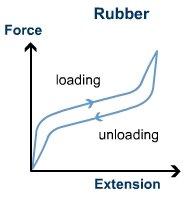Diagram
Stress-Strain Curve for Rubbers

Formula
Stress Formula
Longitudinal Stress inside tube =
Where p is internal pressure, r is radius and t is thickness.
Tangential Stress =
Definition
Volume Stress
Volume Stress (or ) Bulk Stress : When a normal stress changes the volume of a body then it is called volume stress. When a solid body is immersed in a fluid, the force at any point is normal to the surface of the body and the magnitude of the force on any small area is proportional to the area i.e., the body is under the action of a pressure P.
Volume Stress =
Definition
Shear Strain
The engineering shear strain is defined as the tangent of that angle, and is equal to the length of deformation at its maximum divided by the perpendicular length in the plane of force application which sometimes makes it easier to calculate.
=
=
Definition
Volume Strain
It is the ratio of the change in volume of a body to its original volume.
If is the original volume of a body and is the volume of the body under the action of a normal stress, the change in volume is .
Volume Strain =
If is the original volume of a body and is the volume of the body under the action of a normal stress, the change in volume is .
Volume Strain =
Definition
Breaking Stress
The stress applied to a material is the force per unit area applied to the material. The maximum stress a material can stand before it breaks is called the breaking stress or ultimate tensile stress. Tensile means the material is under tension.
Example: Find the greatest length of the wire made of material of breaking stress 8 x 10N / m and density 8 x 10 kg / m that can be suspended from a rigid support without breaking.
Solution:
Example: Find the greatest length of the wire made of material of breaking stress 8 x 10N / m and density 8 x 10 kg / m that can be suspended from a rigid support without breaking.
Solution:
Example
Stress at a cross-section for a solid in equilibrium
Example: A Kg load is suspended by a wire of cross section 0.4 mm. What is the stress produced in N/m ?
Solution:
Solution:
Example
Use of fractional change in length and volume
Example: A uniform cylindrical wire is subjected to a longitudinal tensile stress of . Young's modulus of the material of the wire is . the volume change in the wire is %. find the fractional change in the radius?
Solution:
or
Now
or
or
or
or
Solution:
or
Now
or
or
or
or
Example
Method to determine Young's Modulus
Method: To find Young's modulus of a wire measure the unstretched length of wire, stretch it using a weight, measure the extension, measure the cross sectional area using a micrometer.
Further by using the formula:
Young's Modulus can be determined.
Further by using the formula:
Young's Modulus can be determined.
Example
Problems on elasticity where stress in found using equilibrium force analysis

Example: A steel rod of length and two identical brass rod of length each support a light horizontal platform as shown in the figure. Cross-sectional area of each of the three rods is . A vertically downward force is applied on the platform. Young's modulus of elasticity for steel and brass
Solution:
As elongation is given as .
So
and .
Now, is same for all the rods. Adding force on all the rods,
, Using these values in ,
So strain in steel rod is
As
Solution:
As elongation is given as .
So
and .
Now, is same for all the rods. Adding force on all the rods,
, Using these values in ,
So strain in steel rod is
As
| BookMarks |
0 Comments
Post a Comment